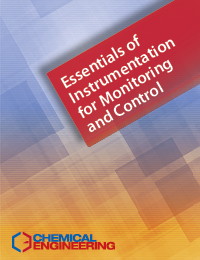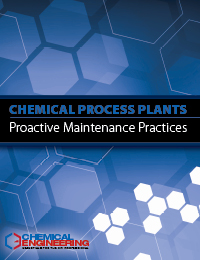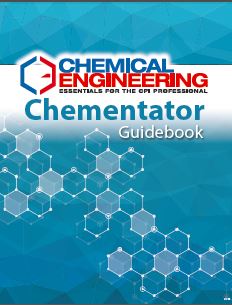Description
Proper use of instrumentation is an integral element of monitoring and control in facilities throughout the chemical process industries (CPI). This Chemical Engineering PDF guidebook provides a diverse collection of articles related to the specification, operation, maintenance and troubleshooting of instrumentation systems used for monitoring temperature, pressure and level.
Included are several engineering articles related to flowmeters. It covers important aspects of sensors for control valve positioning, rupture disks to provide reliable pressure relief, monitoring systems for aboveground and underground piping, aspects of monitoring distillation performance and more. Here you will find concepts of safety-instrumented system (SIS) design and operation.
Delivered in a PDF, 214 pages.
Table of Contents
- Facts at Your Fingertips: Level Measurement Device Selection
- Evaluating Industrial Flowmeters
When it comes to selecting flowmetering devices “one size does not fit all.” Proper meter selection begins with an awareness of flow-measurement science, and a clear understanding of the application requirements
- Advances in Industrial Flowmetering
State-of-the-art flowmeters with advanced diagnostics help to minimize downtime and maximize efficiency and costs
- New Measurement Practices for Cold Climates
New approaches improve reliability and reduce costs in environments with extremely cold temperatures
- The Direct Integration Method: A Best Practice for Relief Valve Sizing
The approach described here is easier to use, and provides more-accurate results, compared to leading valvesizing methodologies
- Viscosity: The Basics
An important concept, sometimes forgotten, is that viscosity is not a single-point measurement
- pH Measurement And Control
When measured correctly, pH can be an invaluable tool for both product and process control
- Distillation Column Thermal Optimization: Employing Simulation Software
Applying process simulation software in distillation column design and operational analysis can lead to significant reductions in operational and maintenance costs and improved column performance
- Facts at Your Fingertips: Low-Pressure Measurement
- Facts at Your Fingertips: Avoiding Pressure Relief Problems
- Facts at Your Fingertips: Causes of Overpressurization
- Facts at Your Fingertips: Control valve position sensors
- Facts at Your Fingertips: Infrared Temperature Measurement
- Facts at Your Fingertips: Selecting Two- and Four-wire Magnetic Flowmeters
- Facts at Your Fingertips: Pressure measurement considerations
- Facts at Your Fingertips: Flowmeter Selection
- Facts at Your Fingertips: Viscosity Measurement
- Facts at Your Fingertips: Level Measurement Devices
- Facts at Your Fingertips: Using Rupture Disks with Pressure Relief Valves
- Heat Transfer Fluid Leaks: Break the Fire Triangle
Extreme processing temperatures present the greatest risk. Know where leaks are most likely to occur and how to prevent them
- Inspecting Underground Piping
First consider noninvasive methods to determine where excavation is — and isn’t — necessary
- Vessel Sizing and Level Instrumentation
When sizing process vessels, it is important to consider instrumentation. Consistent, safe and reliable results depend on it
- Sizing Calculations for Pressure-Relief Valves
A universal mass-flux equation can improve sizing calculations for pressure-relief valves with non-ideal fluids
- Advanced Thermal Dispersion Mass Flowmeters
A look at the principles of operation, installation and calibration
- Safety-Instrumented Systems: Control Valves As Final Elements
The scenarios presented here highlight the advantages and disadvantages of using a control valve in an SIS
- Remote Thermal Sensing
By making it easy to detect heat anomalies, thermal cameras and infrared thermometers support preventive and predictive maintenance
- Flow Measurement in Bitter Cold: How to Use Coriolis Meters In Cryogenic Service
With intelligent setup and operation, mass flow measurements can readily be taken even at extremely low temperatures
- Level Measurement Technologies For the CPI
The application will determine which technology to select
- Aging Relief Systems — Are they Working Properly?
Common problems, cures and tips to make sure your pressure relief valves operate properly when needed
- Infrared Temperature Monitoring: Know the Right Questions to Ask
The infrared approach is especially useful in situations where process temperatures are extremely high, the target is in motion, and the need to avoid contaminants is significant
- Beyond Flowmeter Selection: Consider Some of the Most Overlooked Criteria
The whole-product-lifecycle approach presented here encompasses more than basic selection
- Decoding Pressure Vessel Design
Bridging the gap between users’ and manufacturers’ responsibilities for the ASME pressure vessel code
- Measuring Flow
Understanding how flowmeters work and the pros and cons of each type of device can help in selecting the right one
- Industrial Control Systems Security: The Owner-Operator’s Challenge
Addressing the cybersecurity of industrial control systems requires a collaborative response, beginning with a realistic assessment
- Combining the use of Rupture Discs with Relief Valves
Using the two devices together offers significant benefits in chemical processes. Here is how to take advantage of them
- Dilute-phase Pneumatic Conveying: Instrumentation and Conveying Velocity
Follow these guidelines to design a well-instrumented and controlled system, and to optimize its conveying velocity
- Warming up to Accurate Temperature Measurement
Proper specification, installation and operation can ensure the accuracy required of your temperature sensor
- Wireless Communication in Hazardous Areas
Consider these criteria in deciding where wireless fits in today’s CPI plants and the explosive atmospheres that permeate them
- Inline Viscosity Measurements
Process viscometers can help keep process control and product quality in check
- Piping-System Leak Detection and Monitoring for the CPI
Eliminating the potential for leaks is an integral part of the design process that takes place at the very onset of facility design
- Going Wireless
Using this technology to optimize overall operations offers longterm benefits for the bottom line
- Design of Experiments (DoE): Optimizing Products and Processes Efficiently
Learn how DoE can help save time and money in process design and optimization with this primer
- Energy Efficiency: Tracking Natural Gas With Flowmeters
Thermal mass flowmeters provide advantages over other options for metering the consumption of natural gas by individual combustion units throughout the facility
- Pressure Transmitter Basics: Selection Guidelines
Climbing the decision tree to pick the right pressure sensor
- Pressure Transmitter Basics: DP Transmitters
How a variety of process parameters can be measured with DP transmitters
- The Next Step Change in Process Safety
Leveraging the convergence of operational and information technologies can aid in minimizing risk
- Measurement Best Practices for Safety Instrumented Systems
How to comply with new standards to maximize plant safety and availability while minimizing life-cycle costs
- Applying CPI Temperature Sensors
Don’t fall back on outdated rules of thumb that may no longer be valid, or ‘plug and play’ solutions that may not be applicable
- Condition Monitoring Methods for Pumps
Applying condition monitoring tests to pumps can save costs by optimizing overhaul scheduling




